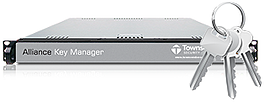I often speak with organizations that need to employ encryption and external key management for multiple relational databases they are using to store encrypted data. Often this is a combination of Oracle and Microsoft SQL Server databases.
Transparent Data Encryption (TDE) is used within both the Microsoft SQL Server and Oracle Database universes to provide encryption services at the tablespace level. Many companies employ TDE and external encryption key management to meet the concept of "Separation of Duties" as required by PCI DSS and other compliance regulations. Also, TDE is often easier to implement than column level encryption that may require programming changes to your application layer.  In Microsoft's SQL Server Enterprise edition 2008/2012 you have access to Extensible Key Management (EKM). When EKM is enabled, SQL Server users can use encryption keys stored on external key managers, as opposed to accessing local key stores, which doesn't line up with compliance requirements. Also, another benefit of using EKM is that you can easily take advantage of TDE as your database encryption approach.
In Microsoft's SQL Server Enterprise edition 2008/2012 you have access to Extensible Key Management (EKM). When EKM is enabled, SQL Server users can use encryption keys stored on external key managers, as opposed to accessing local key stores, which doesn't line up with compliance requirements. Also, another benefit of using EKM is that you can easily take advantage of TDE as your database encryption approach.
If you're running versions of Microsoft SQL server that don’t support EKM, don't worry. You can still take advantage of the added features and security of using an external key manager with our encryption key management HSM, Alliance Key Manager (AKM). AKM fully supports the entire Microsoft SQL Server product line. You’ll just have make some programming changes to your application code to perform the necessary API calls to the key manager and you'll be set up to do key retrieval. To help you with the process, we provide sample code and the .Net key retrieval assemblies to add to your project. Additionally, we have C# and VBNET sample code that shows how to retrieve a key from the key server.
Much like Microsoft SQL Server, in the land of Oracle you need to be running Oracle Enterprise Edition with the Advanced Security option. This can often be a pricey upgrade and I find that quite a few organizations would rather do column level encryption due to this fact.  AKM fully supports the path to column level encryption within the Oracle 10g and 11g environments. Again your approach will include making coding changes to your application layer to perform key retrieval from AKM. To help you with this on the Oracle front we provide some PL/SQL sample code for you to work from.
AKM fully supports the path to column level encryption within the Oracle 10g and 11g environments. Again your approach will include making coding changes to your application layer to perform key retrieval from AKM. To help you with this on the Oracle front we provide some PL/SQL sample code for you to work from.
For more information on the importance of encryption key management, download our white paper "Key Management in the Multi-Platform Envrionment" and learn how to overcome the challenges of deploying encryption key management in business applications.


 As a company that provides NIST-certified encryption and FIPS 140-2 encryption key management, we need to secure data on a number of different platforms. Lately we have been coming into several cases where a customer needs encryption and key management on both Microsoft SQL Server and Oracle databases. Below is an email exchange with a customer who came to us “looking for a product to store, generate and manage keys that we use to encrypt/decrypt credit card information inside both SQL Server and Oracle Databases on Windows and UNIX.” We hope this discussion helps with your encryption project.
As a company that provides NIST-certified encryption and FIPS 140-2 encryption key management, we need to secure data on a number of different platforms. Lately we have been coming into several cases where a customer needs encryption and key management on both Microsoft SQL Server and Oracle databases. Below is an email exchange with a customer who came to us “looking for a product to store, generate and manage keys that we use to encrypt/decrypt credit card information inside both SQL Server and Oracle Databases on Windows and UNIX.” We hope this discussion helps with your encryption project. Key Generation:
Key Generation:
 I just listened to a discussion of database security hosted by Oracle that was very well done. At one point the discussion turned to current threats and how the Enterprise has lost the ability to use perimeter protection for sensitive data. This has been a topic of much discussion in the security area for the last few months. Perimeter protection is based on the use of Firewall and similar technologies to keep the bad guys out, but this approach is failing with the advance of more sophisticated attacks, the use of social media by large organizations, the advance of mobile technologies, insider threats, and the migration of applications to cloud platforms. The trend is called “de-perimeterization” and represents a bit of a challenge to organizations that need to protect sensitive data.
I just listened to a discussion of database security hosted by Oracle that was very well done. At one point the discussion turned to current threats and how the Enterprise has lost the ability to use perimeter protection for sensitive data. This has been a topic of much discussion in the security area for the last few months. Perimeter protection is based on the use of Firewall and similar technologies to keep the bad guys out, but this approach is failing with the advance of more sophisticated attacks, the use of social media by large organizations, the advance of mobile technologies, insider threats, and the migration of applications to cloud platforms. The trend is called “de-perimeterization” and represents a bit of a challenge to organizations that need to protect sensitive data.